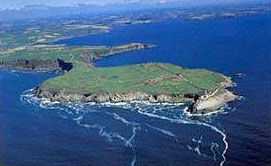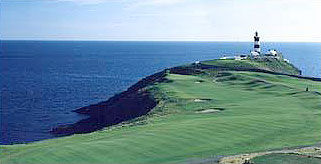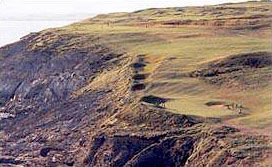Old Head GolfLinks - An Irish Golf Adventure

The southern coast of Ireland has one of the most attractive towns in the entire country. Kinsale was for centuries a cultural and physical center of pre-Christian Irish tribes. In more recent times, it was an unassuming seaport fishing village, located near the mouth of the Brandon River that wound to the sea a short distance away. Today, it is a thriving and bustling tourist center, drawing parades of Americans and other nationals to its quaint shops and restaurants that line very narrow streets reminiscent of postcard-pretty villages you might see in the south of France. It is no place for vehicles, yet in high season, especially, traffic jams are common on streets where pedestrians seem to fight cars for space.
The transition is attributed to British restaurateur Peter Barry who was taken by the village's charm. He bought a Spanish pub and then opened a second restaurant across the street called Man Friday. Offering outstanding cuisine then, today it is regarded as one of the best eateries in Kinsale, if not all of Ireland. Barry's culinary vision drew other restaurateurs to Kinsale, subsequently transforming the town into the Culinary Capital of Ireland. Kinsale's tradition of world-class dining is preserved by the Good Food Circle, an association of local restaurants which sponsors the Kinsale's Gourmet Festival every October.
Located across the main street from the small harbor with its sailing and fishing vessels at anchor is Perryville House, a Victorian guest house that could easily fit into New Orleans' French Quarter. Built by U.S. Adm. Oliver Hazard Perry in the late 1700s for his bride, the house retains its homey personal atmosphere with 22 high ceilinged guest rooms, a book-filled library and reception room with fireplace. It also has a splendid dining room where guests are treated to wonderful home-cooked breakfasts. I couldn't have picked a more attractive residence from which to visit Old Head GolfLinks and Fota Island Golf Club.
As with any other consumer product, golf courses tend to be the subjects of hyperbole, with marketers slinging superlatives around like so many air-borne golf balls on a driving range. While verbal extravagance might be suspect with some golf courses, it is definitely not with Old Head GolfLinks, arguably one of the most spectacular golf courses in the world.
A guest at Perryville House who played the course the day before I did described it as "very easy" while confirming that the scenery was truly awesome. After my own experience, I concluded he was half right. Built along cliffs hundreds of feet above the sea, the course is a scenic marvel. It is also an outstanding layout in its own right.
Located some 8 miles west of Kinsale, Old Head GolfLinks sits on a 220-acre promontory high above the Atlantic. Looking like a swollen thumb jutting out to sea, the promontory is connected to the mainland by a very narrow strip of land that is primarily farmland.
The course site has both historical and environmental significance. Old Head of Kinsale is a National Monument and was once a stronghold of the ancient Eireann Celts who gave their name to the country. The Anglo-Norman invasion beginning in 1169 ushered in a long period of Norman occupation. Remnants of castles and stone circles, as well as churches and dwellings built on the site by monks during Medieval times, are visible throughout the course. One relic of note is the Stone of Accord or Wedding Stone, an upright circular stone with a small hole in the center used for centuries by tradesmen and married couples who would link fingers through the hole signifying the renewal of their contracts.

For years prior to the development of the golf course, the site was usable for little more than sheep and cattle grazing and even then it was scarcely suitable. At the tip of the headland is the lighthouse that presides over the course and lit the way for many seafarers. The waters just off shore was witness to the Battle of Kinsale in 1601 when the Spanish Armada sailed in to help the Irish fight off the invading British warships. Here also was where a German U-boat sank the Lusitania in 1915, bringing the U.S. into the first World War.
The preservation of endemic flora and fauna was paramount in the development of the golf course which began in 1989 by Ashbourne Holdings Ltd., a company owned by Irish-American real-estate developers John and Patrick O'Connor. Enchanted by the site, they aimed to produce one of the world's greatest golf courses on land that was more full of rocks than soil. To route the course, they hired a team that included Dr. Joe Carr, one of Ireland's greatest amateur golfers; Eddie Hackett and Ron Kirby, whose design resume includes stints with Robert Trent Jones, Jack Nicklaus and Gary Player.
In what must be one of the most remarkable engineering feats in the annals of golf course construction history, the owners first had to break up and remove thousands of tons of rock and then import tons of topsoil, as the site was totally devoid of an earthen sub-grade that could support a consistent, durable turf. The early years of development were an exercise in patience and frustration, as no sooner would a hole be completed than punishing rains would wipe it out. In time, the topsoil "took," and the course was able to open in 1997.

The course plays to a par of 72 and ranges from 5,439 to 7,121 yards. The designers used virtually every available square inch of space to produce a fine routing plan that is both simple and interesting. There are no gimmicks here, just straight-forward golf holes that present a variety of shot-making challenges. After a straight 392 opener, the course quickly moves along the cliffs with the 407-yard dogleg left 2nd from an elevated tee box to a cliffside green. An excellent seaside par-3 3rd is followed by the 4th, another medium-length dogleg left that heads straight for the lighthouse. The hole is called "The Razor's Edge" for good reason. A series of various length par 4's and reachable par 5's follow until the outstanding 9th, a slight dogleg left up hill 470 yarder to a well bunkered green.
As good as the front side is, the back 9 is arguably even stronger. It features the 526-yard dogleg left 12th, arguably Old Head's signature hole. A large rock visible from a cliffside tee box is the aiming point for the blind tee shot that must carry a portion of the curving cliff to reach the landing area. From there, the fairway slopes dramatically downhill along the cliff to a green that is very long front to back but is as narrow as a noose. Under construction when I played the course, a new green located some 40 yards behind in a more protected area will replace the existing green which was subject to repeated erosion from the rains and wind.
Speaking of the elements, the weather is a major factor in how you play the course, particularly holes 16 and 17. A 199-yarder, No. 16 plays from another cliffside tee box along yet another cliff. The green is partially hidden by a wall built directly on the cliff and because of the curvature of the land you feel you are playing a dogleg right par 3. At 600 yards, No. 17 runs along the high coast, running fairly straight downhill to about 100 yards in front of the green where the fairway bends right. Par these two holes in calm weather and you earn bragging rights. Bogey them when the winds are blowing and the drinks should be on you.
The weather at Old Head is as moody as a drunk on a spree, one minute beaming, the next streaming with tears. The cloudy day I played started out calmly, with the wind playing scarcely any factor in club selection or shot performance. By the time we got to 12 the rain began and the wind started kicking up. By 14, the clouds got coal black and the winds increased to 25 knots. By 16, the temperature had dropped 15 degrees and we were in a major gale. I looked out on the black, roiling sea and was reminded of Nicholas Montsarrat's novel, The Cruel Sea, about a World War II British corvette that plied these waters and was eventually torpedoed to the bottom of the ocean.
By the time we reached the modern clubhouse, we were torpedoed - soaked and chilled to the bone and completely worn out from the wind. The attractive bar was filled with other casualties including one group that had enough sense to walk in from No. 15 before rigor mortis set in. The weather of course is not always like that. The day before was cloudless and warm, the best day the locals had seen in a long while.
At Old Head, the American style amenities include electric carts, a large driving range with pyramids of balls included in your round, and even a refreshment cart lady. They say that when fog sweeps over the course to stop walking and wait to be picked up lest you fall off a cliff into the sea. That is a bit of an exaggeration. Still, avoid the edges and don't drink on the course. If you do so, you will be ok.
A word on course conditions. The greens were rough (understandable since still immature) and the rough was of manageable length. The greens are moderately sized and their contouring is simple, as is the bunkering. There are some thick patches of marram grass in selected places which could be a problem but the main challenge is keeping your shots from falling over the cliffs.
In summation, by all means don't visit Ireland without stopping at Kinsale and enjoying the golf course. It will provide you with the some of your best golf memories.
An Irish Golf Adventure
- Royal County Down and Royal Portrush
- Royal Dublin Golf Course
- Druids Glen
- The K Club
- Rosses Point, Enniscrone and Carne
- Connemara
- Ballybunion
- Lahinch
- Galway Bay Golf & Country Club
- Dooks and Dingle Golf Courses
- Ring of Kerry
- Waterville
- Tralee
- Killarney
- Old Head
- Fota Island
- Mount Juliet
- Adare Manor & Golf Club